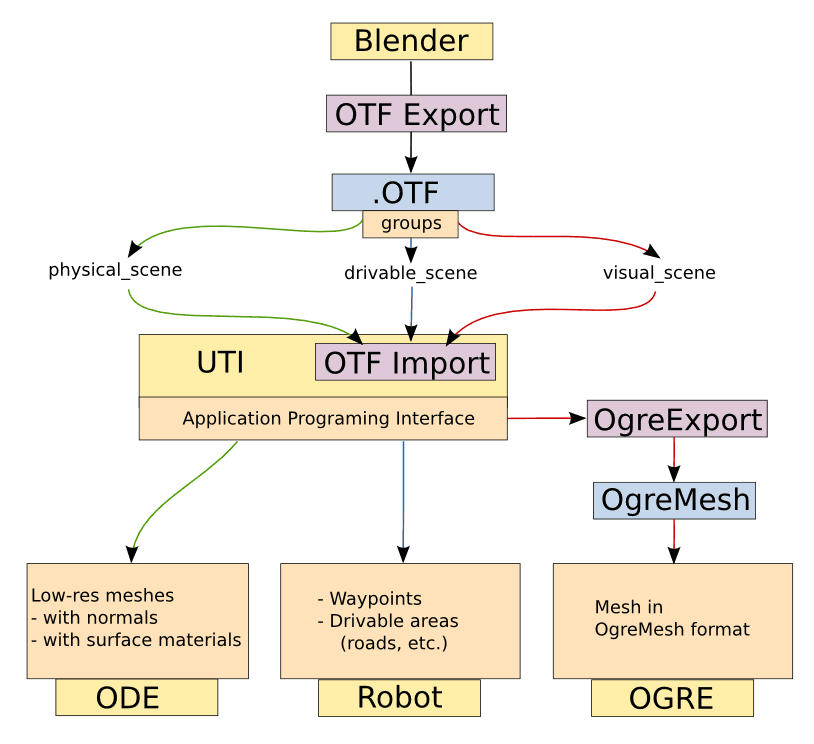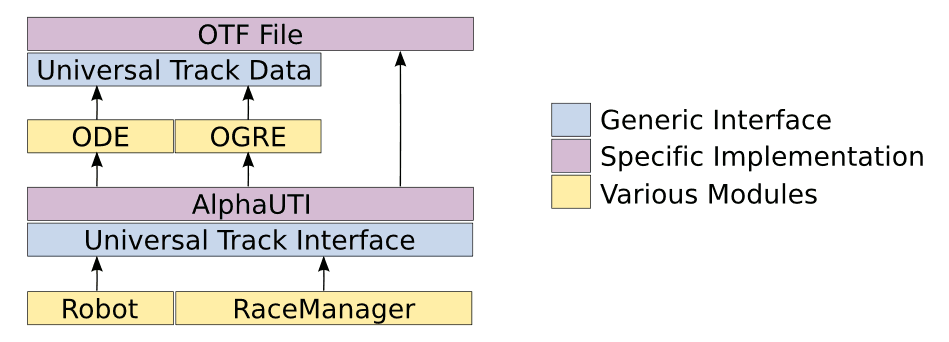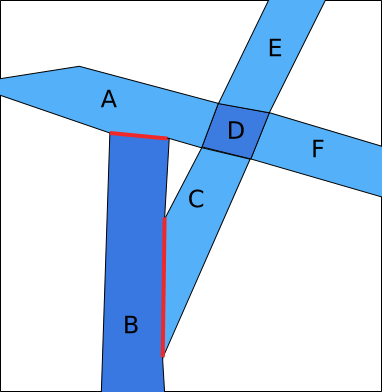Achieving UTI: Difference between revisions
| (26 intermediate revisions by the same user not shown) | |||
| Line 66: | Line 66: | ||
### Ogre? | ### Ogre? | ||
### Robots? | ### Robots? | ||
### RaceManager? | |||
## How blender can define those? | ## How blender can define those? | ||
## How UTI should present this to OpenRacing's modules, in an ''abstract'' way? | ## How UTI should present this to OpenRacing's modules, in an ''abstract'' way? | ||
| Line 82: | Line 83: | ||
== Basic design == | == Basic design == | ||
Initial conception gives this. | |||
[[Image:UTI-Integration.png]] | [[Image:UTI-Integration.png]] | ||
After ''question Q3'', I decided to split UTI into two layers, so the robot is given only a very high level detail of informations whereas physics and graphics can see more details. | |||
[[Image:UTI-UTD.png]] | |||
== Ode needs == | == Ode needs == | ||
| Line 91: | Line 98: | ||
** with physical properties | ** with physical properties | ||
** with normals | ** with normals | ||
=== API === | |||
struct PhysicalSurface { | |||
Vector3[] Vertices; | |||
Vector3[] Normals; | |||
int[] Indices; | |||
float RollingResistance; // Resistance to rolling of the surface | |||
float Friction; // Friction of the surface | |||
} | |||
=== Integration to UTD === | |||
interface UTD { | |||
... | |||
// Returns the surfaces in the physical scene | |||
List<PhysicalSurface> PhysicalSurfaces { get; } | |||
... | |||
} | |||
== Ogre needs == | == Ogre needs == | ||
* 3d model in OgreMesh format. | * 3d model in OgreMesh format. | ||
However, we like the OgreMesh to be generated by code using the UTD interface (see ''Question Q4''). | |||
UTD should provide all necessary data. | |||
=== API === | |||
Let's go straight to the API | |||
struct VisualMesh { | |||
Vector3[] Vertices; | |||
Vector3[] Normals; | |||
Vector3[] Tangents; | |||
Vector3[] Texcoords; | |||
int[] Indices; | |||
// Material associated with this mesh | |||
VisualMaterial Material; | |||
} | |||
// A material with its attributes | |||
struct VisualMaterial { | |||
string Name; // Name of the material | |||
string Type; // Type of material (shader to apply) | |||
// Shader's parameters | |||
Dictionary<string, string> StringProperties; | |||
Dictionary<string, double> FloatProperties; | |||
Dictionary<string, int> IntProperties; | |||
} | |||
=== Integration to UTD === | |||
interface UTD { | |||
... | |||
List<VisualMesh> VisualMeshes { get; } | |||
List<VisualMaterial> VisualMaterials { get; } | |||
... | |||
} | |||
== Robots needs == | == Robots needs == | ||
* | * Way-Points | ||
* Drivable area | * Drivable area (lanes or other areas / parking / etc) | ||
The goal of a robot is to make a car drive to a given waypoint without leaving drivable areas. | |||
He needs to know: | |||
* which drivable area he stands on | |||
* boundaries of this area | |||
* connection to other drivable areas | |||
* his destination | |||
* distance between those areas and the destination (so he can choose the shortest path) | |||
=== WayPoint === | === WayPoint === | ||
A location in space. What we need to know from a way-point is whether we reached it or not. | A location in space. What we need to know from a way-point is whether we reached it or not. | ||
The robot also need a mean to reference it: so it has an Id in the UTI. | |||
==== API ==== | |||
Thus the proposed, very simple API for UTI. | Thus the proposed, very simple API for UTI. | ||
interface | interface WayPoint { | ||
float Distance(Vector3 pos); // distance between waypoint and given position | |||
Vec3 Direction(Vector3 pos); // direction leading to the waypoint from given position | |||
bool Reached(BoundingBox box); // returns true if box reached the waypoint. | bool Reached(BoundingBox box); // returns true if box reached the waypoint. | ||
} | |||
==== Integration to UTI ==== | |||
interface UTI { | |||
... | |||
WayPoint GetWayPoint(string id); // Return WayPoint with given ID | |||
... | |||
} | } | ||
| Line 114: | Line 203: | ||
The surface on which the car is allowed to drive. | The surface on which the car is allowed to drive. | ||
==== API ==== | |||
// Connection to a drivable area (find better name?) | |||
interface Portal { | |||
float DrivingDistance(Waypoint wp); // Returns the driving distance to a given waypoint | |||
List<Vector2> Entry { get; } // The shared vertice between the two drivable areas | |||
DrivableArea To { get; } // The portal is connected to this DrivableArea | |||
} | |||
// Define an area the car can drive onto | |||
interface DrivableArea { | |||
bool IsInside(BoundingBox box); // returns | |||
Collection<Vector2> Boundaries { get; } // Polygon the car is not allowed to go through (except those in portals). | |||
Collection<Portal> Portals { get; } // Connected DrivableAreas | |||
} | |||
==== Example ==== | |||
[[Image:DrivableArea.png]] | |||
DrivableArea '''B''' is connected to DrivableArea '''A''' and '''C'''. Boundaries are in black. Portals in red. | |||
==== Integration to UTI ==== | |||
interface UTI { | |||
... | |||
List<DrivableArea> GetDrivableAreasUnder(BoundingBox box); // Return the drivable areas a vehicle stands on. | |||
... | |||
} | |||
== RaceManager needs == | == RaceManager needs == | ||
The RaceManager takes care of initializing car at specified positions (which is very specific to a simulator but needs to be done). | |||
RaceManager need to be provided an array of possible starting positions. | |||
=== Starting Position === | |||
In addition to avoid putting cars randomly on the road, starting positions will allow to make races. | |||
==== API ==== | |||
interface StartingPosition { | |||
Vector3 Position { get; } | |||
Quaternion Orientation { get; } | |||
} | |||
==== Integration to UTI ==== | |||
interface UTI { | |||
... | |||
List<StartingPosition> StartingPositions { get; } | |||
... | |||
} | |||
== Blender exports == | == Blender exports == | ||
| Line 141: | Line 282: | ||
'''Q3: In order to make UTI as extensible as possible, we like to present very few (or no) datas to high-level code. If Ogre and Ode relies on UTI directly we need to expose them very low-level informations (like the meshes and materials). If a scene exporter relies on UTI, same problem. Is it an issue?''' | '''Q3: In order to make UTI as extensible as possible, we like to present very few (or no) datas to high-level code. If Ogre and Ode relies on UTI directly we need to expose them very low-level informations (like the meshes and materials). If a scene exporter relies on UTI, same problem. Is it an issue?''' | ||
I think we can split the abstraction into two levels. A very high level called Universal Track Interface, presents only algorithms (no data). A lower level presents an abstracted view of datas (which still allows to change lightly the file format, but gives modules access to low-level data (without exposing that to robots or the race manager for instance. | '''[solved]''' I think we can split the abstraction into two levels. A very high level called Universal Track Interface, presents only algorithms (no data). A lower level presents an abstracted view of datas (which still allows to change lightly the file format, but gives modules access to low-level data (without exposing that to robots or the race manager for instance. | ||
[[Image:UTI-UTD.png]] | |||
'''Q4: Will the OgreMesh be generated at runtime?''' | |||
[ | '''[solved]''' In all case (runtime or preprocessing), it's good that the generator use the provided interface so we can change the underlying file format without changing anything dealing with Ogre. So UTD should provide necessary data to generate a visual scene. | ||
Latest revision as of 14:08, 1 August 2009
Intro
C# code design was depending a lot on C++ code due to compatibility constraint with Torcs plugins.
However, with time, we finally ended up rewriting almost everything but the car simulation engine (which is the big part of the simuv2 plugin)
We then removed lot of C++ code, mainly track and robots related code, then their dependencies.
The C# code can now be redesigned properly (without constraints), starting with the track interface (see Universal Track Interface).
Step 1: kill some C++
- 1- We got rid of all C++ code not needed by simuv2.
- 1. we disabled legacy c++ robots, which in turn allowed to remove learning, robottools, plib (almost completely).
- 2. C# code that needed to access/modify t* struct now do it through an interface (called UTI).
- 3. We removed as much C++ code as possible.
- 2- Simplifying simuv2
- simuv2 no longer manages collisions, we got rid of solid.
Progress indicator
The indicator is the number of lines of C++ compiled in libsimulator.so. Goal is 0 (one day maybe).
- 22/06, 05:00pm. 39223 lines
- 23/06, 03:00pm. 32984 lines (removed c++ drivers)
- 23/06, 03:30pm. 31697 lines (removed learning)
- 23/06, 05:00pm. 31565 lines (tried to remove robottools... but track have a dependency over it. simplifying what can be)
- 24/06, 05:00pm. 30817 lines (removed gnulinux)
- 24/06, 06:00pm. 30116 lines (removed simuv2 collision handling code, removed simuv2's dependency over the track format)
- 26/06, 11:00am. 24528 lines (removed track, finished to remove robottools)
- 26/06, 12:30pm. 21975 lines (removed most of plib. cleaning some commented lines)
- 26/06, 07:30pm. 18289 lines (removed solid and portability)
- 26/06, 10:00pm. 17949 lines (removed lot of raceman, cleaning)
Going further
Almost half the remaining C++ code is related to parsing XML and storing/managing GfParm (which is a list of Metadata -- or Dictionnary -- done in C++).
A quick grep approximates that SimuV2 retrieves about 103 static informations about the car from its GfParm files. If we create a structure in which we store those informations, we can then load them from C# (using far-far less code).
When all those 103 informations are loaded from C#, we can drop the txml and tgf c++ modules. Only simuv2 and math will remain (and I guess we then can't go any further except by porting simuv2 to C#).
Torcs' data structures and C#
OpenRacing is still relying on a few data structures which are defined in C++, they are used to keep synchronized simulation state between C++ and C#.
However, the C++ code is now absolutely free of informations about the track. So, concerning UTI's work, we have nothing to change on that part.
Alpha UTI
On the process to remove track from C++, I needed to add a minimal UTI interface in order to be able to run the simulation.
AlphaUTI is an extremely minimalist implementation of it. It gives a single starting position (0,0,2) and point its path to the street-1 folder so Ode and Ogre load their data from there.
We now need to transfer some intelligence from Ode/Ogre to UTI (so an UTI is not just a folder!).
Step 2: Conception
Plan
- Solve the problems
- What informations needs each modules?
- Ode?
- Ogre?
- Robots?
- RaceManager?
- How blender can define those?
- How UTI should present this to OpenRacing's modules, in an abstract way?
- What informations needs each modules?
- Provide class specifications.
- For physics
- For graphics
- For robots
- Implement AlphaUTI and/or tools (depends where the methods goes)
- .OTF (pseudo collada) loader
- convert .OTF to OGRE
- Adapt
- Ode to use UTI
- Ogre to use UTI
- Robots to use UTI
- Enjoy the new track made with blender!
Basic design
Initial conception gives this.
After question Q3, I decided to split UTI into two layers, so the robot is given only a very high level detail of informations whereas physics and graphics can see more details.
Ode needs
Ode needs:
- a list of meshes
- with physical properties
- with normals
API
struct PhysicalSurface {
Vector3[] Vertices;
Vector3[] Normals;
int[] Indices;
float RollingResistance; // Resistance to rolling of the surface
float Friction; // Friction of the surface
}
Integration to UTD
interface UTD {
...
// Returns the surfaces in the physical scene
List<PhysicalSurface> PhysicalSurfaces { get; }
...
}
Ogre needs
- 3d model in OgreMesh format.
However, we like the OgreMesh to be generated by code using the UTD interface (see Question Q4).
UTD should provide all necessary data.
API
Let's go straight to the API
struct VisualMesh {
Vector3[] Vertices;
Vector3[] Normals;
Vector3[] Tangents;
Vector3[] Texcoords;
int[] Indices;
// Material associated with this mesh
VisualMaterial Material;
}
// A material with its attributes
struct VisualMaterial {
string Name; // Name of the material
string Type; // Type of material (shader to apply)
// Shader's parameters
Dictionary<string, string> StringProperties;
Dictionary<string, double> FloatProperties;
Dictionary<string, int> IntProperties;
}
Integration to UTD
interface UTD {
...
List<VisualMesh> VisualMeshes { get; }
List<VisualMaterial> VisualMaterials { get; }
...
}
Robots needs
- Way-Points
- Drivable area (lanes or other areas / parking / etc)
The goal of a robot is to make a car drive to a given waypoint without leaving drivable areas.
He needs to know:
- which drivable area he stands on
- boundaries of this area
- connection to other drivable areas
- his destination
- distance between those areas and the destination (so he can choose the shortest path)
WayPoint
A location in space. What we need to know from a way-point is whether we reached it or not.
The robot also need a mean to reference it: so it has an Id in the UTI.
API
Thus the proposed, very simple API for UTI.
interface WayPoint {
float Distance(Vector3 pos); // distance between waypoint and given position
Vec3 Direction(Vector3 pos); // direction leading to the waypoint from given position
bool Reached(BoundingBox box); // returns true if box reached the waypoint.
}
Integration to UTI
interface UTI {
...
WayPoint GetWayPoint(string id); // Return WayPoint with given ID
...
}
Drivable Area
The surface on which the car is allowed to drive.
API
// Connection to a drivable area (find better name?)
interface Portal {
float DrivingDistance(Waypoint wp); // Returns the driving distance to a given waypoint
List<Vector2> Entry { get; } // The shared vertice between the two drivable areas
DrivableArea To { get; } // The portal is connected to this DrivableArea
}
// Define an area the car can drive onto
interface DrivableArea {
bool IsInside(BoundingBox box); // returns
Collection<Vector2> Boundaries { get; } // Polygon the car is not allowed to go through (except those in portals).
Collection<Portal> Portals { get; } // Connected DrivableAreas
}
Example
DrivableArea B is connected to DrivableArea A and C. Boundaries are in black. Portals in red.
Integration to UTI
interface UTI {
...
List<DrivableArea> GetDrivableAreasUnder(BoundingBox box); // Return the drivable areas a vehicle stands on.
...
}
RaceManager needs
The RaceManager takes care of initializing car at specified positions (which is very specific to a simulator but needs to be done).
RaceManager need to be provided an array of possible starting positions.
Starting Position
In addition to avoid putting cars randomly on the road, starting positions will allow to make races.
API
interface StartingPosition {
Vector3 Position { get; }
Quaternion Orientation { get; }
}
Integration to UTI
interface UTI {
...
List<StartingPosition> StartingPositions { get; }
...
}
Blender exports
UTI's API
http://bazaar.launchpad.net/~openracing/openracing/trunk/annotate/head%3A/src/core/UTI.cs
AlphaUTI
Questions
Q1: Should the robot decide the features of his car?
It seems more natural to me to build a car then put a driver into the car (instead of the opposite). Maybe some AI are very specific to drive a particular car.
[solved] Let's forget about complications first: we simplify!
Q2: For blender, we may also need an OTF importer, can we share this code with UTI (C#)?
If we store .blend file next to .otf file, that is not necessary. But what if the .OTF file comes from other mean (like an eventual Torcs to OTF convertion tool)?
Q3: In order to make UTI as extensible as possible, we like to present very few (or no) datas to high-level code. If Ogre and Ode relies on UTI directly we need to expose them very low-level informations (like the meshes and materials). If a scene exporter relies on UTI, same problem. Is it an issue?
[solved] I think we can split the abstraction into two levels. A very high level called Universal Track Interface, presents only algorithms (no data). A lower level presents an abstracted view of datas (which still allows to change lightly the file format, but gives modules access to low-level data (without exposing that to robots or the race manager for instance.
Q4: Will the OgreMesh be generated at runtime?
[solved] In all case (runtime or preprocessing), it's good that the generator use the provided interface so we can change the underlying file format without changing anything dealing with Ogre. So UTD should provide necessary data to generate a visual scene.


